Inception
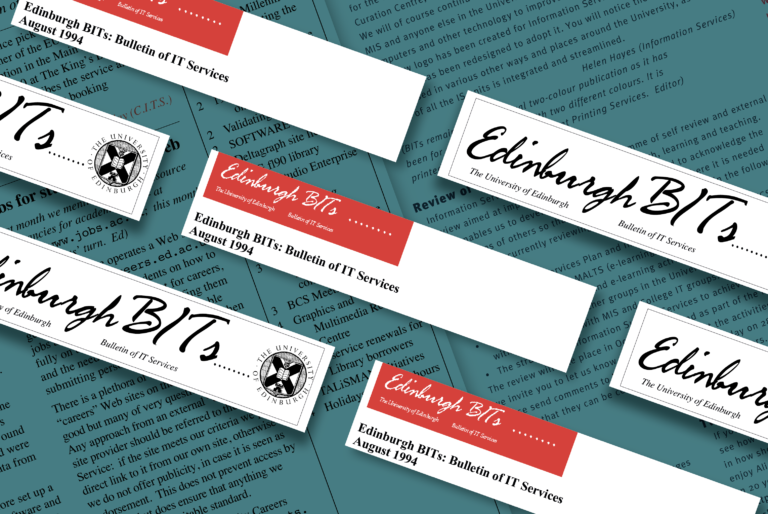
In 1990, Frances Allen (Manager of the Training and Documentation Unit), launched the Bulletin of IT Services – or BITs for short – published monthly and edited by Nick Stroud (Computing Officer). Produced by the Edinburgh University Computing Services (EUCS), BITs reported on the latest developments in communications and information technology at the University until Information Services was formed in the early 2000s.
Meet BITs in its earliest iteration as the IT Bulletin, where the story begins with the rise of digital technologies in communications, learning and teaching at the University.
Technologies don’t appear in a vacuum. They emerge as a product of the people behind them and environments around them. Ultimately, successful implementation of technology depends on understanding and supporting a community’s unique needs. Nick describes the importance of BITs in serving the University’s wider communities of staff and students.
Watch Nick tell the story of the inception of Bulletin of IT Services (BITs) in an interview with Graphic Design Manager Sonia Virdi.
|
The evolution of the design of BITs – its layout, style, and presentation – mirrors the growth of computing as a central service for the University. Technology in the early 1990s was not as ubiquitous as it is today – the World Wide Web wasn’t yet in every pocket or even in every classroom. As computers and the Web appeared more prominently in teaching and learning, BITs provided an important source of news and information about these growing technologies. Graphic design served as a vital tool to communicate these momentous and complex changes.
|
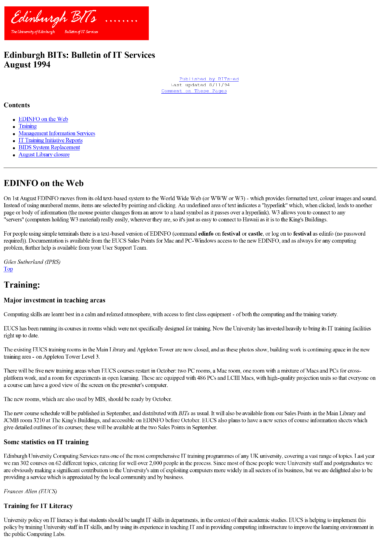
The design of the first iteration of the BITs used a header in bright red to establish some visual identity for the bulletin, referencing the University brand red. Nick himself acknowledges that he’s not a designer and, at the time, didn’t have any professional design support. Therefore, the design of this early issue is more functional. The use of the blue hyperlinks and early 'comments' feature would have been relatively new and unfamiliar. These simplified elements might be a window into the future, showing us where design might be headed in the 21st century. These early 90s digital design contain fewer images and almost no media – for a good reason. The data required to load these visual elements via Web would have been very expensive. From a sustainability perspective today, graphic designers increasingly opt for simpler designs that communicate the content clearly but keep data-heavy media to a minimum.
|
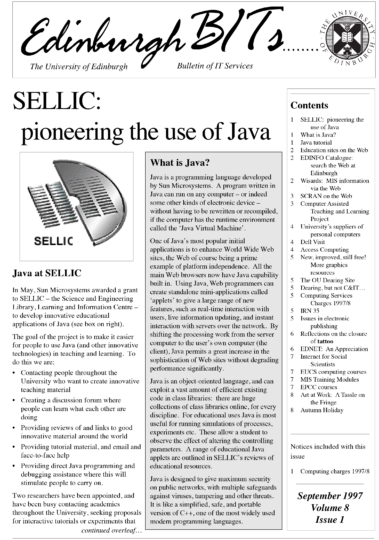
By September 1997, the second iteration of BITs shows more consideration of design, expanding the BITs header image, displayed in a handwriting font, across the top of the page. The use of University design elements, including the University crest, increases alignment with the University brand, establishing BITs as a corporate document with a University-wide audience. The increased use of design features shows an intent to communicate more clearly the purpose and standing of the publication.
|
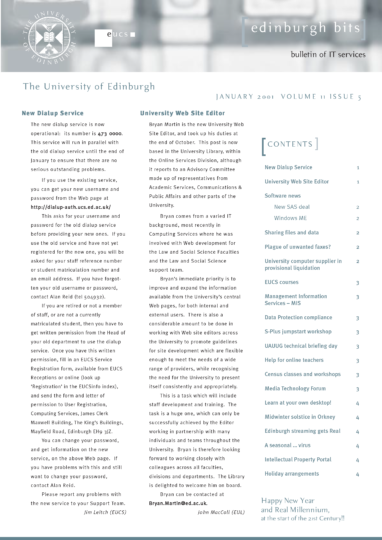
The third iteration maintains the columns and header but reflects the professional design support of the centralised Visual Resources team. The handwriting font used for the BITs header has been replaced by a logo that imitates the aesthetic of text generated by a computer, with square brackets and all lower-case letters. Using elements that reflected popular design style and typography of the early 2000s era – mixing different fonts and using mismatched bracket sizes – helped to create more modern publication. This approach moved away from the more traditional graphic approaches seen across other University publications, generating some controversy at the time. In addition, EUCS-specific branding appeared, establishing a visual identity for the central computer services.
|
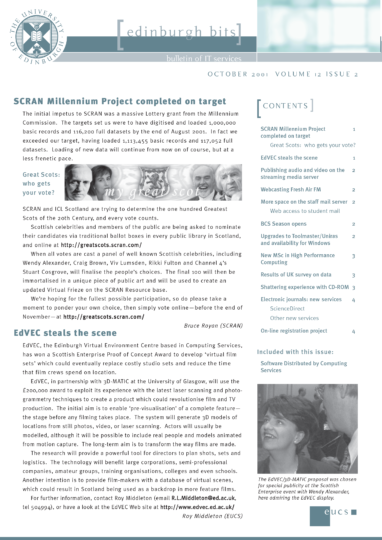
This fourth iteration of BITs design demonstrates a refinement of the third iteration with increased use of quality images, including images of human faces – the people behind the machines. Though more professional, this iteration of design still reflects creative choices and deviations from official corporate communications. The graphic in the top right-hand corner reflects a technological tartan. Listen to Nick explain its origins in this interview with Sonia in the video below.
The design of BITs did not stand still but evolved to reflect the growing role and scope of central IT Services. From a one-person project to a layout and cover design by a team of professionals, BITs became increasingly streamlined for wider audiences. Watch Nick Stroud, Nora Mogey, and Sonia Virdi explore the early designs of BITs.
|
The upgrades to the graphic design of BITs reflect the growing profile of technology in learning, teaching, research, and administration in the 1990s. These articles each demonstrate new or updated services enabled by emerging technologies that brought with them new ways of working and learning. These changes prompted questions about how best to use technology to support social responsibility and widen access to quality education.
While new technologies bring new opportunities, they also bring new challenges and risks. Despite the best intentions, the impact and repercussions of using particular systems can be difficult to predict.
Click the arrows to explore notable news items from BITs throughout the years as new technologies emerged.
|
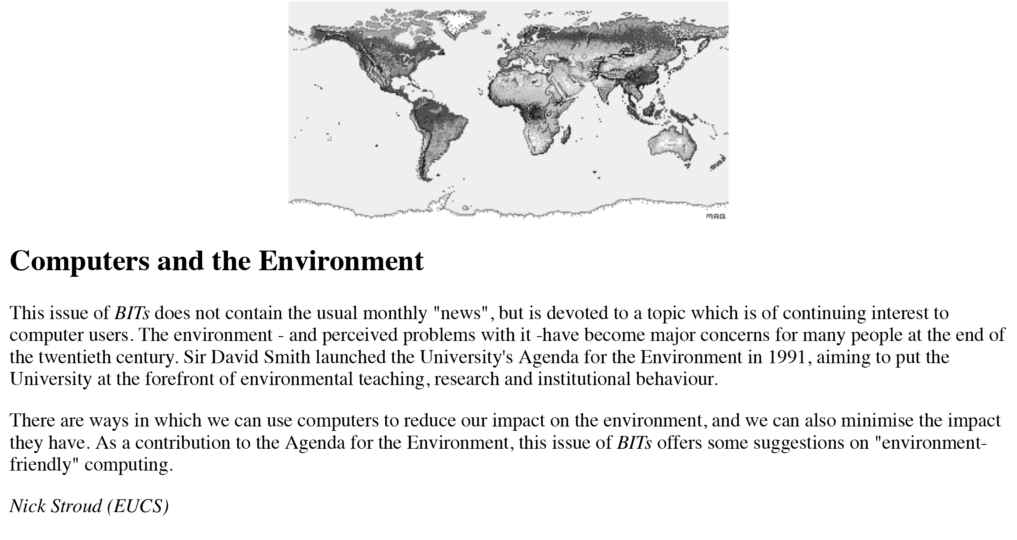
The University’s mission to understand its impact on the environment and address the effects of climate change is not a recent phenomenon. According to this Special Green issue of BITs published in May 1994, ‘Sir David Smith launched the University's Agenda for the Environment in 1991, aiming to put the University at the forefront of environmental teaching, research and institutional behaviour.’ Computing services were at the heart of this initiative, with articles both about environmentally friendly use of computers and about the solution presented by technologies such as email to reduce use of paper. The final issue of BITs, published in Autumn 2019, focussed on ‘Sustainable IT’ showing how this initiative to make the University greener has persisted and evolved over the past 30 years.
|

On the 1 August 1994, the University’s ‘website’ EDINFO moved to the World Wide Web. The move to ‘W3’ would provide ‘formatted text, colour images and sound’. In this issue of BITs, Giles Sutherland explains: ‘An underlined area of text indicates a "hyperlink" which, when clicked, leads to another page or body of information…’. It’s hard to imagine a time when the navigation and basic functionality of the Web weren’t second nature. These innovative features in 1994 just go to show how far the Web has advanced since the 1990s. Before W3, the Internet was not necessarily global. As Sutherland tells us: ‘W3 allows you to connect to any "servers" (computers holding W3 material) really easily, wherever they are, so it's just as easy to connect to Hawaii as it is to the King's Buildings.’
|
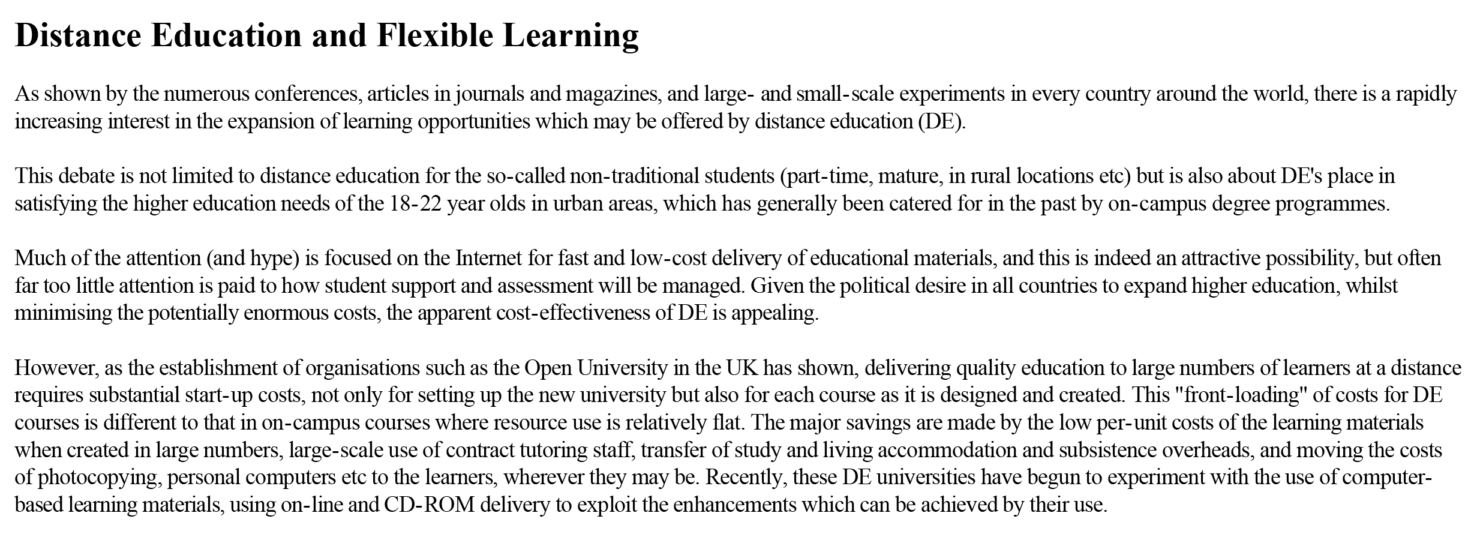
Before digital technologies, access to education was largely limited to those with the ability to attend lectures in-person. In the 1990s, central IT rolled out new platforms to make education more accessible to a wider, more diverse range of students. Dr Jeff Haywood, Director of Flexible Learning at the University of Edinburgh in 1997 explains: ‘This debate is not limited to distance education for the so-called non-traditional students (part-time, mature, in rural locations etc) but is also about DE's place in satisfying the higher education needs of the 18-22 year olds in urban areas, which has generally been catered for in the past by on-campus degree programmes.’ These new Distance and Flexible Learning platforms have a renewed significance for those of us living in the post-COVID-19 world, where remote studying and working became the only way to study and work safely.
|
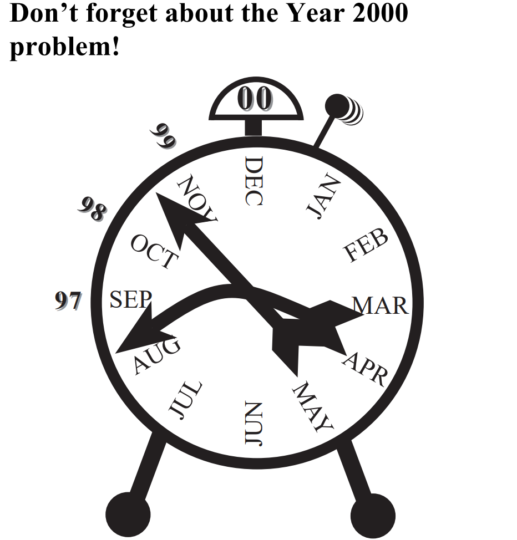
In 1999, the Y2K bug made headlines across the world. For younger viewers, the Y2K bug referred to a widespread fear that computers would malfunction at 00:00 on 1 January 2000 as computer clocks weren’t programmed past 1999. This type of widespread public concern about unknown consequences of new technologies can be seen today. Introducing new technologies comes with potential risks. While the Y2K scare never came to anything, the rise of AI-driven services and growing market share of only a handful of tech corporations raises new questions about the future impact of adopting new technologies.
‘I was very keen to use BITs to say, don't waste, you know, think of the environment. Use computers to help that sort of research. Just be aware that the world is in a lot of trouble. Even 20 years ago, it was obvious.’ – Nick
The early issues of BITs show us that even 30 years ago, the University — and society more widely — expressed many of the same concerns we have today. Many issues of BITs from the 1990s and early 2000s feature articles on how to use computers and technology to reduce the impact of climate change, for example. Central IT Services at this time also devoted a great deal of resource and effort into developing systems to enable wider, more inclusive access to higher education. Listen to these audio clips on how BITs teaches us about the relationship between technology and the environment and technology and social responsibility.
In this audio clip, Nick and Nora describe the momentous technological changes since the early 1990s.
‘Yes, we had computers. They didn't have very big memories. [...] We were using CD ROMs and floppy discs and those kinds of things.’ – Nora
‘There's far more memory in the phone you've just had put next door than the whole EMAS multiuser access service ran on when it was really the forefront of computing. And that was much more than the total computing power that put men on the moon in 1969.’ – Nick
|
Play this audio clip to learn about the Learning Technology team’s approach to building useful learning platforms.
‘The Open University's model of recording a lecture and putting it up wasn't really the route that we wanted to go [...]. You could get computers to do things that you couldn't easily do yourself in a classroom or in a seminar room or a lecture hall.
‘And that was what we should try and go for.’ – Nora
|
